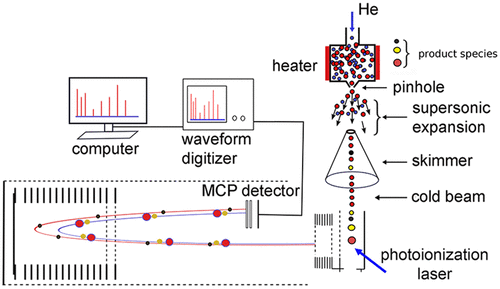当前位置:
X-MOL 学术
›
J. Phys. Chem. A
›
论文详情
Our official English website, www.x-mol.net, welcomes your feedback! (Note: you will need to create a separate account there.)
PAH/Aromatic Tar and Coke Precursor Formation in the Early Stages of Triglyceride (Triolein) Pyrolysis
The Journal of Physical Chemistry A ( IF 2.9 ) Pub Date : 2018-03-07 00:00:00 , DOI: 10.1021/acs.jpca.7b11340 Ibrahim Alhroub 1 , Evguenii Kozliak 2 , Alena Kubátová 2 , Mark Sulkes 1
The Journal of Physical Chemistry A ( IF 2.9 ) Pub Date : 2018-03-07 00:00:00 , DOI: 10.1021/acs.jpca.7b11340 Ibrahim Alhroub 1 , Evguenii Kozliak 2 , Alena Kubátová 2 , Mark Sulkes 1
Affiliation

|
There has been a limited understanding of high MW polycyclic aromatic hydrocarbon (PAH) product chemistry in the pyrolysis of triglycerides (TGs), though the subject has important implications for both fuel production from TGs and food science. Previous TG pyrolysis studies have been able to identify only relatively low MW GC-elutable aromatics occurring in the bulk liquid phase; products occurring in the solid phase have remained inaccessible to chemical analysis. In contrast, cold gas expansion molecular beam methods, where pyrolysis products are analyzed in real time as they are entrained in gas expansions, remove product collection difficulties, thereby allowing for analysis of coke/tar PAH precursors. In this study, the model TG triolein was heated and the ensuing products in the molecular beam were soft photoionized, enabling time-of-flight mass detection. Use of 266 nm pulses enabled selective photoionization of aromatic products. Unlike previous work on analysis of the liquid phase TG cracking products, a different and distinct pattern of rather large PAHs, up to 444 amu, was observed, at nontrivial relative product fractions. With an increase of temperature to ∼350 °C, a small number of PAHs with MW ≥ 276 amu increasingly dominated the aromatic product distribution. Surprisingly, PAH product detection ensued at rather low temperatures, as low as ∼260 °C. For tentative PAH product identification and product chemistry rationalization, we observed the product homology pattern and applied a stoichiometric analysis. The latter, combined with the known homology profiles of TG cracking products, indicated specific patterns of intermediate fragment association that facilitated large-MW PAH formation as a result of TG cracking.
中文翻译:

PAH /芳族焦油和焦炭前体在甘油三酸酯(Triolein)热解早期的形成
尽管甘油三酸酯(TGs)的产生对燃料生产和食品科学都具有重要意义,但对甘油三酸酯(TGs)热解过程中高分子量多环芳烃(PAH)产品化学的认识仍然有限。先前的TG热解研究仅能鉴定出在整体液相中出现的相对较低的MW GC可洗脱的芳烃。固相中的产物仍无法进行化学分析。相比之下,冷气膨胀分子束方法在热膨胀产物夹带在气体膨胀中时会对其进行实时分析,从而消除了产物收集的困难,从而可以分析焦炭/焦油PAH前体。在这项研究中,模型TG三油精被加热,分子束中的后续产物被软光电离,启用飞行时间质量检测。使用266 nm脉冲可实现芳族产品的选择性光电离。与先前分析液相TG裂解产物的工作不同,在相对重要的相对产物分数下,观察到了高达444 amu的相当大PAH的不同模式。随着温度升高到约350°C,少量的MW≥276 amu的PAHs逐渐占据了芳香族产品的主导地位。令人惊讶的是,随后在低至260°C的低温下检测出PAH产品。对于暂定的PAH产品鉴定和产品化学合理性,我们观察了产品同源性模式,并进行了化学计量分析。后者与TG裂解产物的已知同源性相结合,
更新日期:2018-03-07
中文翻译:

PAH /芳族焦油和焦炭前体在甘油三酸酯(Triolein)热解早期的形成
尽管甘油三酸酯(TGs)的产生对燃料生产和食品科学都具有重要意义,但对甘油三酸酯(TGs)热解过程中高分子量多环芳烃(PAH)产品化学的认识仍然有限。先前的TG热解研究仅能鉴定出在整体液相中出现的相对较低的MW GC可洗脱的芳烃。固相中的产物仍无法进行化学分析。相比之下,冷气膨胀分子束方法在热膨胀产物夹带在气体膨胀中时会对其进行实时分析,从而消除了产物收集的困难,从而可以分析焦炭/焦油PAH前体。在这项研究中,模型TG三油精被加热,分子束中的后续产物被软光电离,启用飞行时间质量检测。使用266 nm脉冲可实现芳族产品的选择性光电离。与先前分析液相TG裂解产物的工作不同,在相对重要的相对产物分数下,观察到了高达444 amu的相当大PAH的不同模式。随着温度升高到约350°C,少量的MW≥276 amu的PAHs逐渐占据了芳香族产品的主导地位。令人惊讶的是,随后在低至260°C的低温下检测出PAH产品。对于暂定的PAH产品鉴定和产品化学合理性,我们观察了产品同源性模式,并进行了化学计量分析。后者与TG裂解产物的已知同源性相结合,



























 京公网安备 11010802027423号
京公网安备 11010802027423号